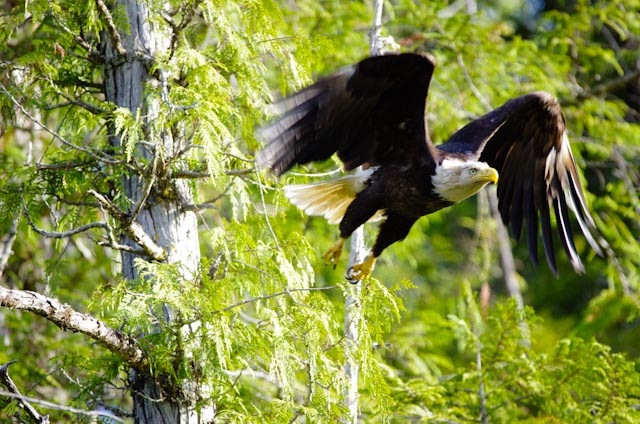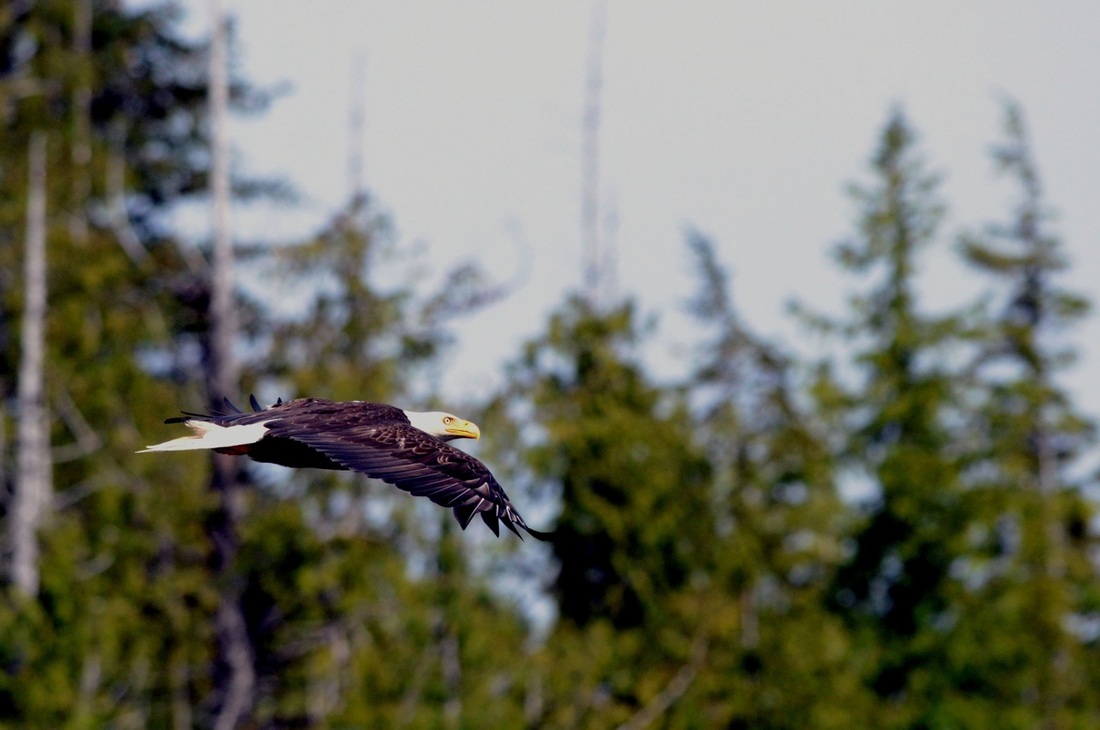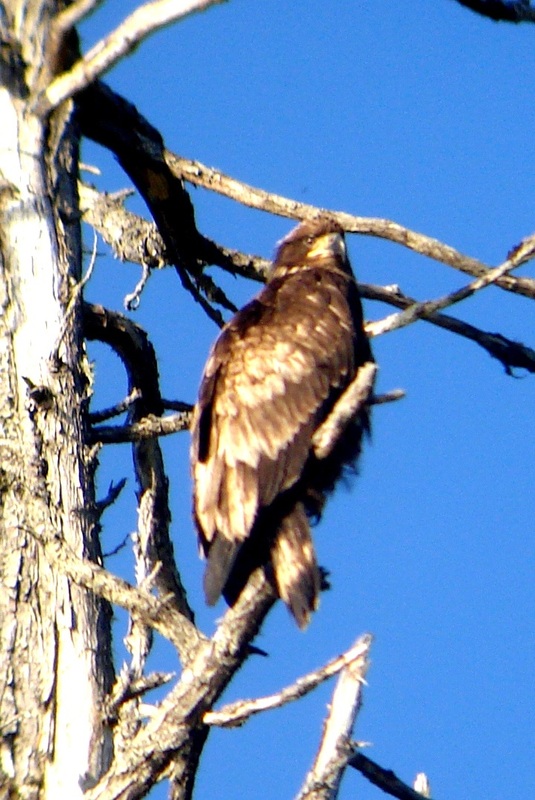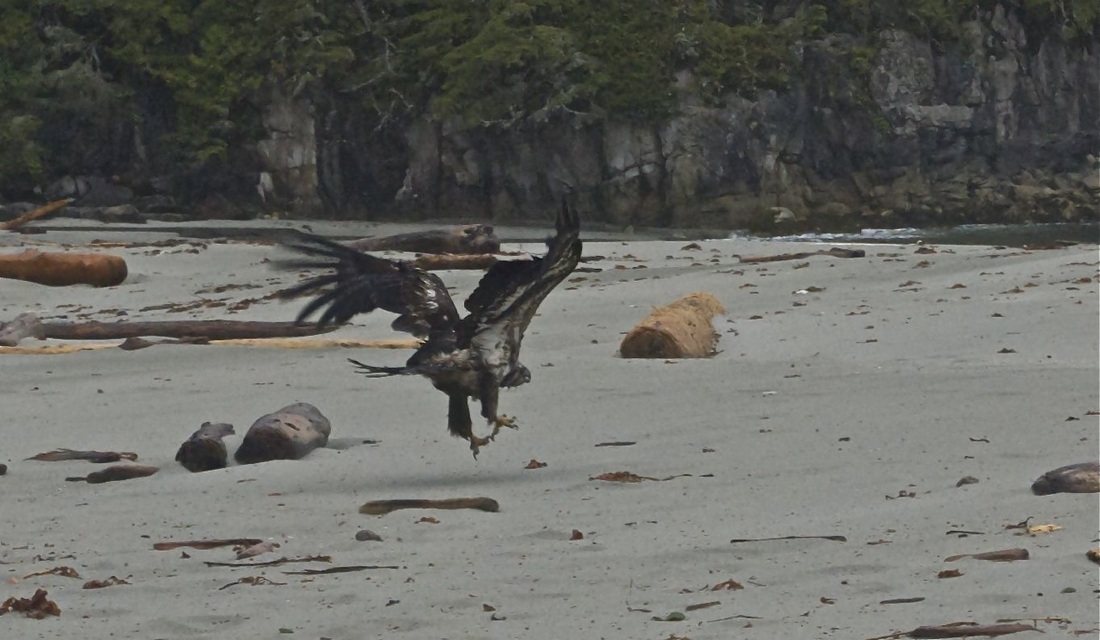Bald eagle • Haliaeetus leucocephalus • Heiltsuk/Haíɫzaqv - Wíkv
Top: adult bald eagles, photos by Jennifer Walker (top) and Chris Darimont (raincoast.org). Middle: juvenile bald eagles, photos by ES 470 participants. Scroll down for more bald eagle photos.
Identification
This iconic bird is large and easily distinguishable by its white head and tail and yellow bill. It soars with its wings outstretched flat. Juveniles are harder to identify, as they do not have the distinctive white patches, but are nearly all brown with mottled white. Younger birds will have black bills, changing to yellow as they age. Birds will not attain adult plumage until they are about 5 years old. Click here for more detailed descriptions of this species at all life stages.
Habitat & Range
The bald eagle is found year-round in the Pacific Northwest, and across most of Canada in the summer breeding months. Some birds are migratory; those that are return south to the United States and parts of Central America in the winter. Large numbers of this bird can be seen on some rocky islands on the Central Coast.
Find more information at the British Columbia Breeding Bird Atlas account here.
Similar Species
Juvenile bald eagles look very similar to juvenile golden eagles (Aquila chrysaetos). The former have patchy brown and white undersides of their wings, while the latter have a more defined pattern. Juvenile golden eagles also have smaller heads with golden napes (top of head and back of neck).
Intriguing Info
The bald eagle underwent large population declines in the early and mid-1900s, largely because of eggshell thinning from pesticides, particularly DDT. It was considered Endangered in the United States from 1978 to 2007. It was never listed as at risk by the Committee on the Status of Endangered Wildlife in Canada (COSEWIC), although it was listed as Endangered by Ontario and New Brunswick. The bald eagle has made a dramatic comeback since conservation measures began and DDT was banned in the 1980s. They are not currently considered at risk in British Columbia.
The bald eagle, like many other raptors, exhibits reversed sexual dimorphism, whereby the female is larger than the male.
iNaturalist
https://www.inaturalist.org/taxa/5305-Haliaeetus-leucocephalus
This iconic bird is large and easily distinguishable by its white head and tail and yellow bill. It soars with its wings outstretched flat. Juveniles are harder to identify, as they do not have the distinctive white patches, but are nearly all brown with mottled white. Younger birds will have black bills, changing to yellow as they age. Birds will not attain adult plumage until they are about 5 years old. Click here for more detailed descriptions of this species at all life stages.
Habitat & Range
The bald eagle is found year-round in the Pacific Northwest, and across most of Canada in the summer breeding months. Some birds are migratory; those that are return south to the United States and parts of Central America in the winter. Large numbers of this bird can be seen on some rocky islands on the Central Coast.
Find more information at the British Columbia Breeding Bird Atlas account here.
Similar Species
Juvenile bald eagles look very similar to juvenile golden eagles (Aquila chrysaetos). The former have patchy brown and white undersides of their wings, while the latter have a more defined pattern. Juvenile golden eagles also have smaller heads with golden napes (top of head and back of neck).
Intriguing Info
The bald eagle underwent large population declines in the early and mid-1900s, largely because of eggshell thinning from pesticides, particularly DDT. It was considered Endangered in the United States from 1978 to 2007. It was never listed as at risk by the Committee on the Status of Endangered Wildlife in Canada (COSEWIC), although it was listed as Endangered by Ontario and New Brunswick. The bald eagle has made a dramatic comeback since conservation measures began and DDT was banned in the 1980s. They are not currently considered at risk in British Columbia.
The bald eagle, like many other raptors, exhibits reversed sexual dimorphism, whereby the female is larger than the male.
iNaturalist
https://www.inaturalist.org/taxa/5305-Haliaeetus-leucocephalus
References
Anonymous. (n.d.) Bald Eagle (Haliaeetus leucocephalus), The Birds of North America Online (A. Poole, Ed.). Ithaca: Cornell Lab of Ornithology. Accessed on 27/01/13.
Bald Eagle (Haliaeetus leucocephalus). ARKive.org. Accessed on 28/03/13.
Blood, D. A. and Anweiler, G. G. (1994). Status of the Bald Eagle in British Columbia. Accessed on 27/01/13.
Dunn, J. L. and Alderfer, J. (Eds.). (2006). National Geographic Field Guide to the Birds of North America. (5th Ed.). Washington, D.C.: National Geographic Society. P. 124
Authors and editors of page
Chanda Brietzke and Brian Starzomski (2013).
Anonymous. (n.d.) Bald Eagle (Haliaeetus leucocephalus), The Birds of North America Online (A. Poole, Ed.). Ithaca: Cornell Lab of Ornithology. Accessed on 27/01/13.
Bald Eagle (Haliaeetus leucocephalus). ARKive.org. Accessed on 28/03/13.
Blood, D. A. and Anweiler, G. G. (1994). Status of the Bald Eagle in British Columbia. Accessed on 27/01/13.
Dunn, J. L. and Alderfer, J. (Eds.). (2006). National Geographic Field Guide to the Birds of North America. (5th Ed.). Washington, D.C.: National Geographic Society. P. 124
Authors and editors of page
Chanda Brietzke and Brian Starzomski (2013).








